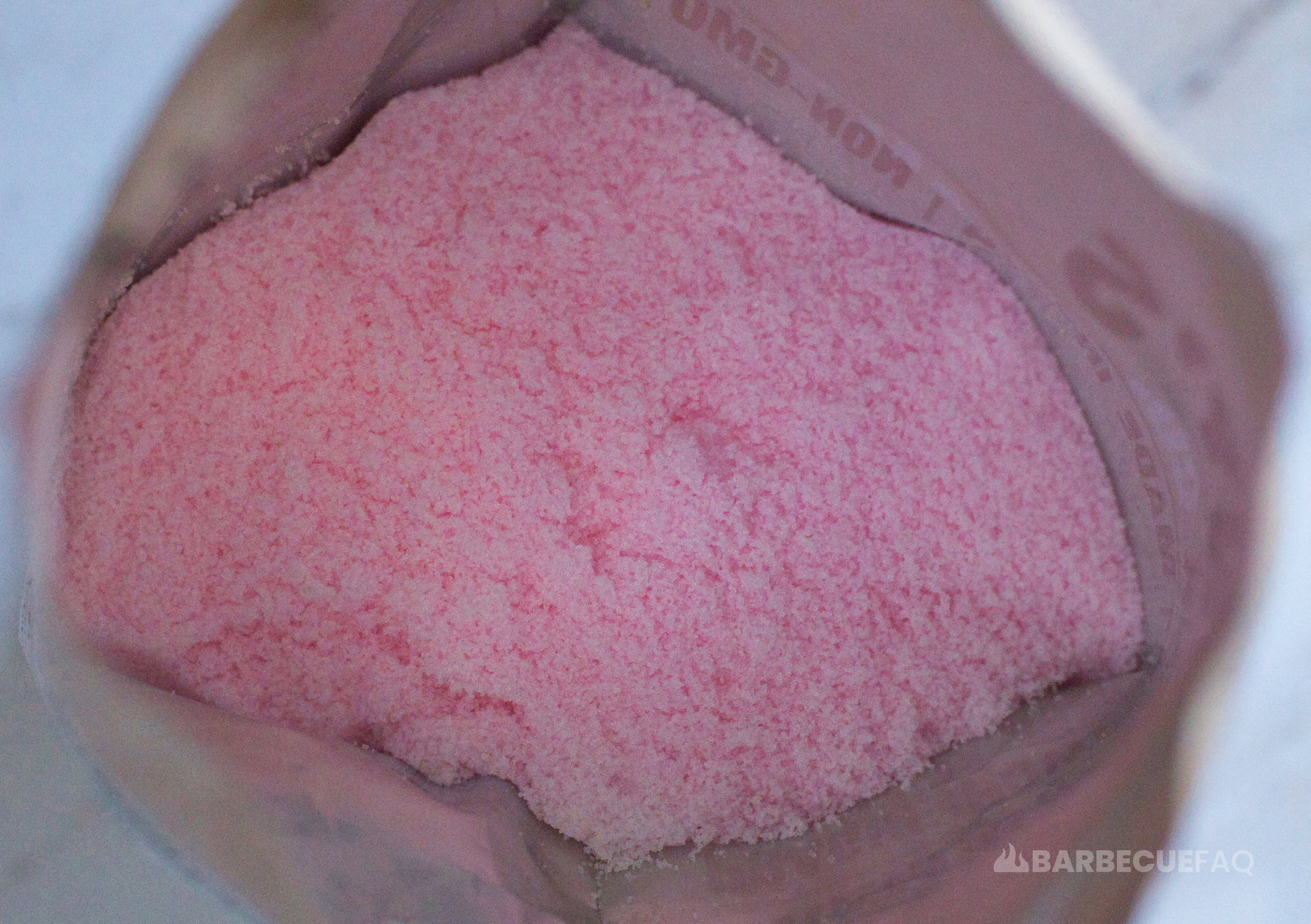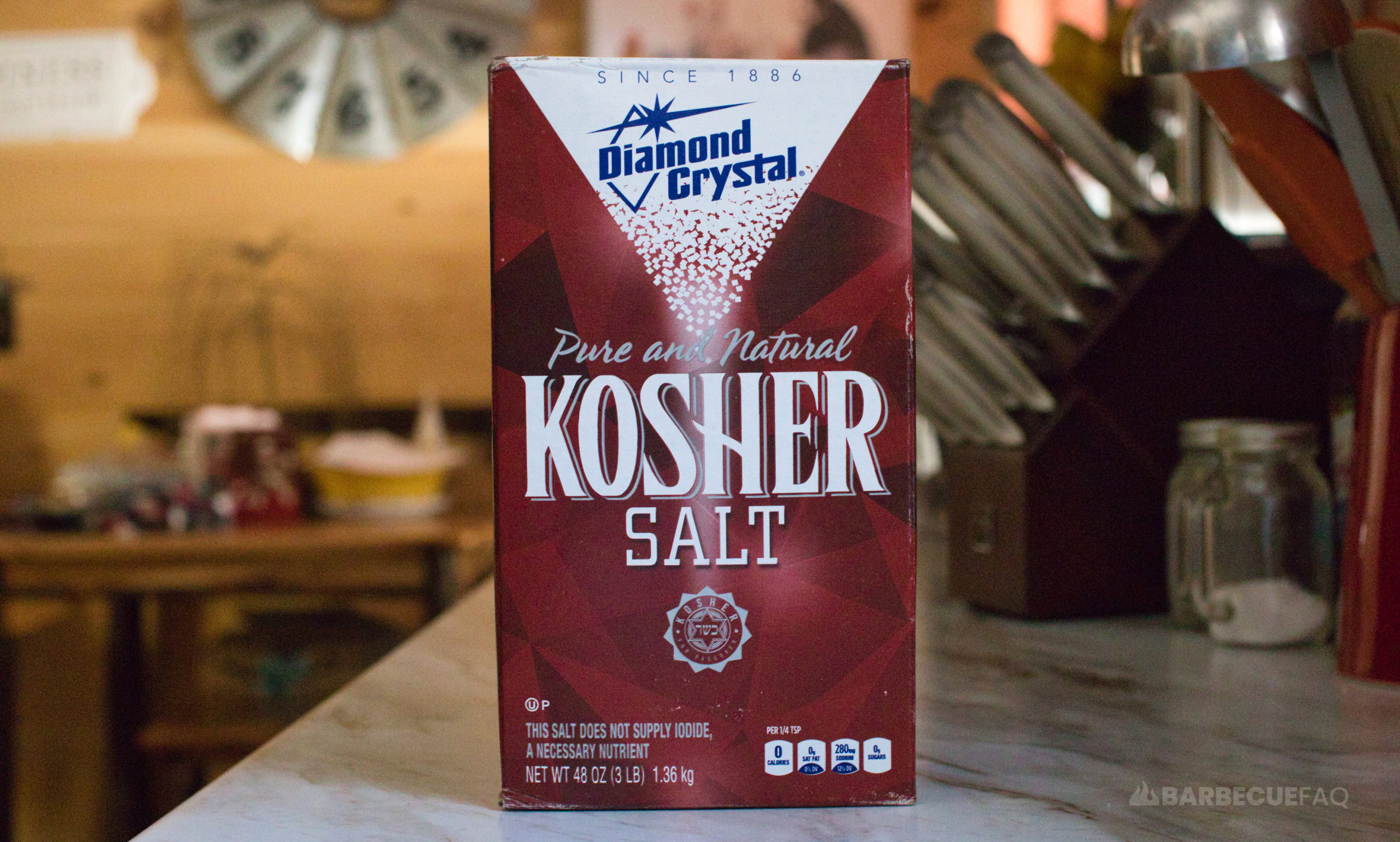If you’re using curing salt for jerky, you want to use Cure #1, not #2.
Here’s a picture of the brand I use:

Cure #1 will also go by names like:
- InstaCure #1
- Pink Curing Salt #1 (not to be confused with pink Himalayan sea salt)
- Prague Powder #1
#1 consists of 6.25% sodium nitrite and 93.75% sodium chloride; This version requires cooking – hence why it’s used for jerky.
What Does Curing Salt Do for Jerky?
The whole point of using nitrites and nitrates is to help with shelf life and to inhibit anaerobic bacteria (namely Clostridium botulinum).

Sodium nitrite is a salt that is anti-microbial and functions as an anti-oxidant meaning it helps with shelf and color stability.
These curing agents or salts work via processes like osmosis and diffusion.
More or less, salt kills microbes because of the effect of osmolarity; Salt works to pull moisture out of the meat thus decreasing the water activity.
How to Use Curing Salt With Jerky
Something to make abundantly clear:
It’s extremely important that you measure the correct quantities of cure (grams) based on the amount of meat you’re working with.
This same reason is why Curing salts are dyed Pink (Red #3); So you don’t confuse them for regular salt.
- The scale I use is made by Etekcity – you can find that scale here.
- I also use Anthony’s Pink Curing Salt #1 – you can find that here.
Breaking Down How Much Curing Salt to Use
Anthony’s Pink Curing Salt #1 Notes: 1 oz of Cure #1 per 25 lbs of meat. BUT most of us are making small batches of 1-5 lbs at most.
Rather, we know that 1 oz is 28.35 grams.
Meaning, we can convert this to our quantities like this:
(28.35g / 25 lbs) * X lbs = Y Grams- Where X is the weight of the beef.
- Y is the cure output in grams.
If we had 3 lbs of beef, the equation would look like this:
(28.35g / 25 lbs) * 3 lbs = 3.402g of Cure #1This is a simple calculator I made.
Input your weight in lbs for gram(s) of cure output.
Salt-based Ingredients and Organic Acids as Curing Agents
Lots of factors go into microbial survival and growth, namely drying temperature, low water activity, and the use of preservatives like salt and organic acids.

In terms of food-grade organic acids you’ll see things like vinegar (acetic acid), citric acid (citrus fruits), or ascorbic acid (vitamin C).
This is the reason almost every single recipe for jerky will use some form of salt as it functions as a curing agent.
Salt really has 4 functions:
- Flavor enhancer
- Inhibits microbial growth
- Improves shelf-stability
- Increases protein hydration
Chances are, if a brand states they’re “nitrate, nitrite, and preservative free” they’re using some form of “salt” or “organic acid” in the ingredients list.
To Demonstrate, Here’s an Example with Savage Jerky Co.
They advertise on their packaging and on their website that they’re “All Natural” and “Low Sodium, No Preservatives” and “No Nitrates or Nitrites Added.”
Looking at their ingredients list for their “Lime & Garlic Mojo” flavor tells us:
“BEEF, LIME JUICE, WATER, ORANGE JUICE, LEMON JUICE, MOLASSES, SEA SALT, BROWN SUGAR, GARLIC, SPICES“
Savage Jerky Co.
To break down the curing agents:
- Lime juice has an acidic pH between 2-3 and has antimicrobial properties; Also contains proteolytic enzymes.
- Orange juice has an acidic pH of 3.9. While antimicrobial to some extent, it’s likely used for flavor in this recipe; Also contains proteolytic enzymes.
- Lemon Juice has an acidic pH between 2-3 and has antimicrobial properties; Also contains proteolytic enzymes.
- Sea salt is used as a curing agent.
Sugars like Molasses and Brown Sugar are typically used to balance out the salt.
Also important: Molasses and sugar are both humectants which helps to bind to the moisture inside the jerky while still keeping the water activity low.
This aids in making the jerky softer.
Since Savage Jerky doesn’t use nitrates or nitrites, they note their jerky lasts for 1 week after being opened.
So as we can see, shelf-life is compromised BUT most people who buy jerky, especially small 2 oz. packages are eating the entire package.
This time-frame is also consistent with homemade jerky that doesn’t use a curing salt and isn’t vacuum sealed.
I Don’t Want to Use Cure, What are My Options
So you can either add your own salt or use salt-based ingredients.
Personally, I always use around 3/4 – 1 cup of liquid per lb of meat.
My base liquid for most of my jerky recipes is:
- 1/3 Cup Low Sodium Teriyaki Sauce
- 1/4 Cup Tamari Soy Sauce
- 1/4 Cup Water
- 2 Tbsp Worcestershire Sauce
If you want to use just water, you’d go with around 30-35g (roughly 2 tbsp-ish of diamond crystal kosher salt) in 400 grams of water (1 and 2/3 cup).
You’d then add your own sugar to compensate for the saltiness (1+ tbsp of dark brown sugar is a good start), but adding more will make it softer and sweeter.
Important Note: Beef Jerky Cure Isn’t Required by the USDA
Contrary to popular belief, cure for jerky, isn’t required by the USDA.
Even exploring their website:
“Products may be cured or uncured, dried, and may be smoked or unsmoked, air or oven dried.”
USDA.gov
The jerky industry is heavily regulated by the USDA and the Food Safety Inspection Service (FSIS). Meaning, the barrier to entry is pretty substantial and all jerky products sold are clearly labeled as follows:
“U.S. Inspected and Passed by Department of Agriculture”
The reason I say this is because there are several hundred brands, if not thousands that advertise with labels like:
- Nitrate and Nitrite free
- Free of preservatives
- Insert variations of wording like the above
Brands like Savage Jerky wouldn’t exist if Nitrates and Nitrites were required ingredients.
I personally don’t have much of a bias in regards to using cure or not as I’ve used both over the course of 15 years of making jerky.
However, the point stands, cures help to extend shelf-life. If you were to check the shelf-stability of products with labels like Savage Jerky co., they will all state that their product lasts a week after being opened.
Meaning, if you don’t intend on your jerky lasting a week, is a cure necessary for you? Likely not.
Most of my jerky is lucky if it lasts 2-3 days, let alone a week. Even our example of Savage Jerky, a 2 oz. portion of jerky is likely going to be consumed in one sitting deeming cure unnecessary.





2 comments
Tom Sander
Hello Dylan. Cleaning out seasoning cabinet and came across 5 bags of “Jerky Cure w/Maple Sugar Net Wt. 2 Oz (56g) C1495 29015. No brand name and no instructions. Cleaning out freezer for new deer season so making jerky. Any idea how to safely use this stuff?
Dylan Clay
That’s a tough call Tom as all these brands are “quoted” for different amounts. Sometimes they’ll sell them as “2oz” too and give you 1 oz. of cure and 1 oz. of seasoning
When I was younger my Dad and I used to use the pre-made ones that were 2 oz. for 5 lbs of meat (1 oz. cure and 1 oz. of seasoning).
Do you know if it’s an all-in-one packet or is it packages that include multiple packets like the above?